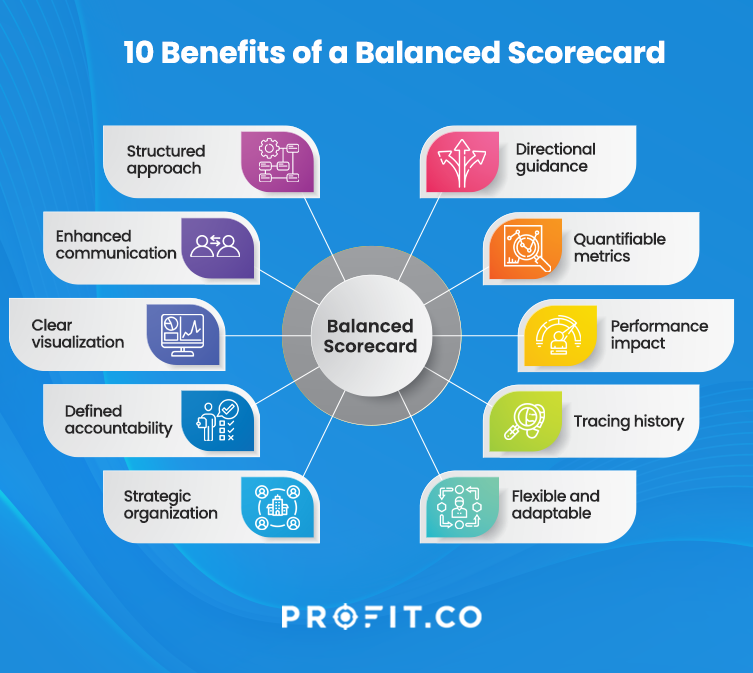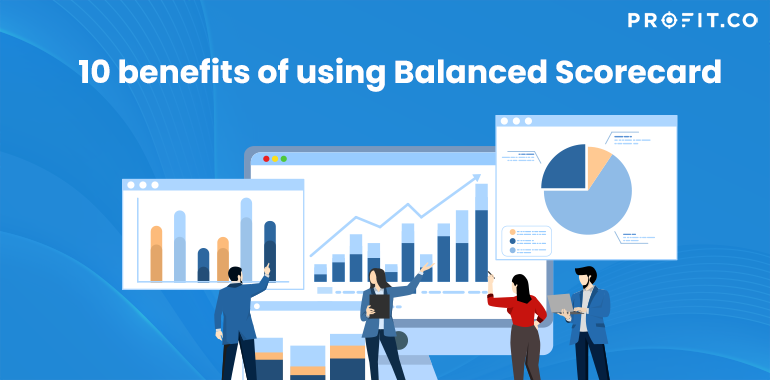Those at the highest level of a company are responsible for providing guidance and direction to the rest of their employees throughout the business. There are several ways to do this, but the main goals are to set objectives, observe the competition, order the internal hierarchy, decide on strategy, and ensure it is communicated to every level of the organization. Given how long we have been doing this, there are several recommended strategies to choose from, with several complimenting each other. This blog will discuss the advantages of balanced scorecard gives a business.
What is a Balanced Scorecard?
A Balanced Scorecard is a performance metric used to evaluate internal performance and its resulting outputs. Initially used only by for-profit companies, it is now used by non-profits and government organizations. The reason for this is how versatile it is. A balanced scorecard measures a company’s intellectual capital, which can mean the skills, training, knowledge, and unique information that gives this business its competitive edge over others. Generalized further, it has four areas, or legs, typically seen:
- Learning and growth
Investigates the training and disbursement of knowledge to employees. How well employees use this knowledge to gain an advantage in a competitive market is then analyzed. - Business Processes
Here, we analyze the processes involved in manufacturing goods for the business. Operations are tracked to see where there are shortages, gaps, waste, and other inefficiencies. - Customers
Perspectives are gathered from the customers to gauge their level of satisfaction with our product. We want to see whether they are happy with the quality, price, and availability of our offer. - Finance
We collect metrics from several reports, including expenditure, sales, and income. With a variety of information collected, we can look at financial ratios, budgets, and income targets.
“The Balanced Scorecard (BSC) provides managers with the instrumentation they need to navigate to future competitive success.”
We use the balanced scorecard to record objectives, goals, progress, and other measurements within these four areas. The idea is that if enough information is collected, we can identify areas that need improvement and what exactly stops progress in other fields. Future scorecards can be adjusted to account for our previous learnings.
The origins of the balanced scorecard can be traced back a long way, but the official concept of it was introduced in 1992 by David Norton and Robert Kaplan. Theirs was not the only paper on it during that time, but it was the most popular, and in 1996, they published a book called The Balanced Scorecard. The idea of this performance management tool has existed for longer than that, for example, we can see similar concepts in the work at General Electric in the 1950s.
Examples of balanced scorecards exist everywhere, and we probably participate in them without noticing. For example, if you have shopped online, you would probably notice that they always ask for your feedback after making the purchase, typically inquiring about how satisfying your experience was and whether you have any complaints. By giving a rating scale, they can easily calculate averages over different periods, see whether customers are improving their opinions, and where exactly they need to improve. This would come under the Customer leg of a balanced scorecard.
Those who work in the supply chain would be familiar with the Business Processes leg, as much of their job involves identifying inefficiencies along the supply chain. For example, a business choosing to shift to a new transportation method and route for delivery comes from analyzing and realizing their previous methods were inefficient. Clearly, good comes from utilizing a balanced scorecard, but what are the specific advantages that we have identified?
To learn how Profit.co simplifies business processes
10 Benefits of a Balanced Scorecard
As we have seen the balanced scorecard in effect for a few decades now, we can identify 10 clear advantages:
1. Structure
The way a balanced scorecard is divided clarifies what perspectives you need to approach your business from. Though the topics are wide, there is a clear understanding of who will most likely be familiar with them. Supply chain managers would understand business processes as customer service employees would be familiar with the customer’s leg.
2. Communication
The balanced scorecard is a communication powerhouse in organizations It fosters a culture of regular dialogue, enhancing focus on critical objectives. This approach turns communication into a strategic tool, ensuring everyone is on the same page, and contributing cohesively towards shared goals.
3. Visualization
Building a balanced scorecard involves investigating a process from beginning to end. It’s like a clear roadmap, aligning individual and departmental efforts with the broader Srategic goals. This alignment ensures everyone understands their role and its impact. This, in turn, gives you a clear idea of cause and effect, which is especially important when determining the best way to improve performance.
4. Accountability
The information you record must reflect the true nature of affairs. Presenting transparent performance indicators is similar to lighting up a dark room, making complex strategies clear and actionable. Since you will be collecting from different perspectives, it makes it much harder to give false data or poor direction, as it will look like a misshapen puzzle piece in the larger picture. Employees are less likely to be dishonest.
5. Organization
Building a balanced scorecard requires you to have a deep understanding of your business and the specific metrics to use, making it easier to fill in the scorecard. If it is difficult, you now have the opportunity to restructure your organization to remove these challenges, improving your business for the long term.
6. Guidance
Appraising your employees is best done with plenty of information at your disposal. The process of building a scorecard means being more familiar with the individual employees in charge of different sections, allowing you to better appreciate the effort they put in or lack thereof.
7. Metrics
A scorecard best functions when you take all the information you’ve recorded and translate it into accessible metrics. Instead of several pages of data, you have simple ratios and results, which are very useful for presenting to superiors and other stakeholders you are responsible for.
8. Performance
Perhaps the reason most companies even approach balanced scorecards. They are a proven method for increasing the performance of your business. In addition to the other benefits we mentioned before, the results usually speak for themselves.
9. History
The longer your business has used the balanced scorecard, the more information you have. Having this history in an easy-to-access location allows you to be better informed when making future decisions. What worked once can work again if the problem is similar.
10. Adaptability
Above all, the balanced scorecard is flexible. The sections it has are not too restrictive so even if you are in a different industry than usual, you can fit the operations of your business into the balanced scorecard. All it requires is some creative thinking and motivation.

These are the essential points to remember when considering the use of a balanced scorecard in your business. The relevant info to keep in mind is that a balanced scorecard can be used differently depending on the context, so one should take the time to apply it. Doing it once makes it easier for subsequent times.
Real-Life Cases
Philips Electronics
In the 2000s,Philips Electronics used balanced scorecards to align company views and focus employees. Instead of legs, Phillips created critical success factors (CSFs). Their ultimate goal here was to ensure employees understood how management’s current strategies led to their intended vision. They used automation so that quick reporting allowed employees to quickly see the results of their efforts and could regularly review. Long-term use of this allowed them to identify and then share their best practices with all their branches worldwide, creating significant benefits for the company as a whole.
UPS
In 1994, as UPS was undergoing a culture change, its leadership decided they needed a change in the way they measured performance. Before this, most of their focus was on financial measurements, but they had decided to increase their operational excellence or more specifically, “process quality”. They implemented the balanced scorecard framework and by the first quarter of 2000, they had achieved 10 consecutive quarters where fiscal performance kept increasing. They credited the success to how the balanced scorecard helped their employees understand what exactly to work towards and how to do it more efficiently.
Conclusion
Upon reading these benefits, you might wish to implement a balanced scorecard into your own business. There are a multitude of examples to look at on how it might fit into your particular business, but we also live in the age of automation. In addition to these real-life examples, utilizing Balanced Scorecard Software to facilitate the process would perhaps save you time and money in the long run. You just have to consider carefully what best suits your business objectives. By leveraging the capabilities of Balanced Scorecard Software, you can ensure that your performance metrics are accurately tracked, your strategies are effectively communicated, and your business goals are consistently achieved.

